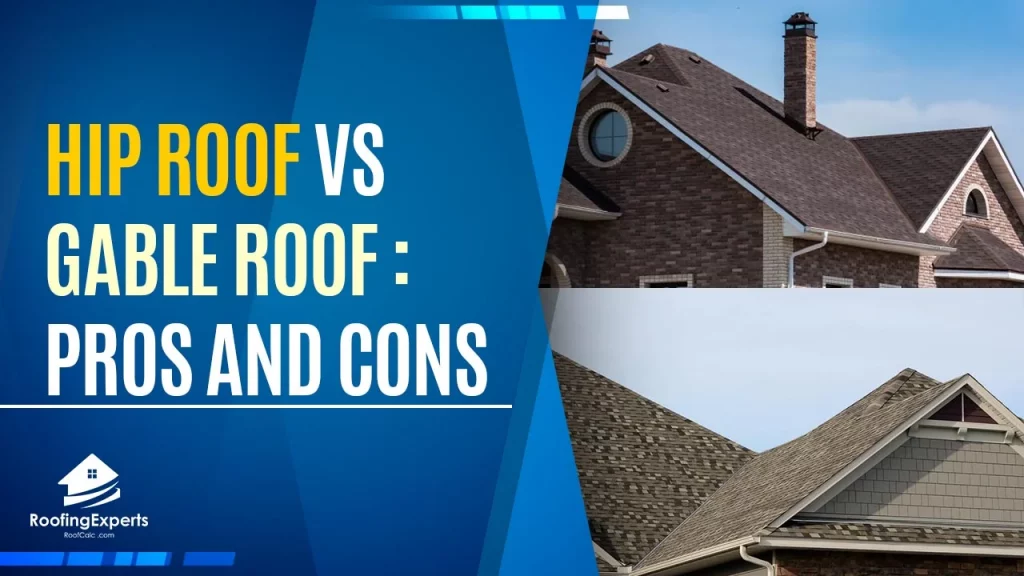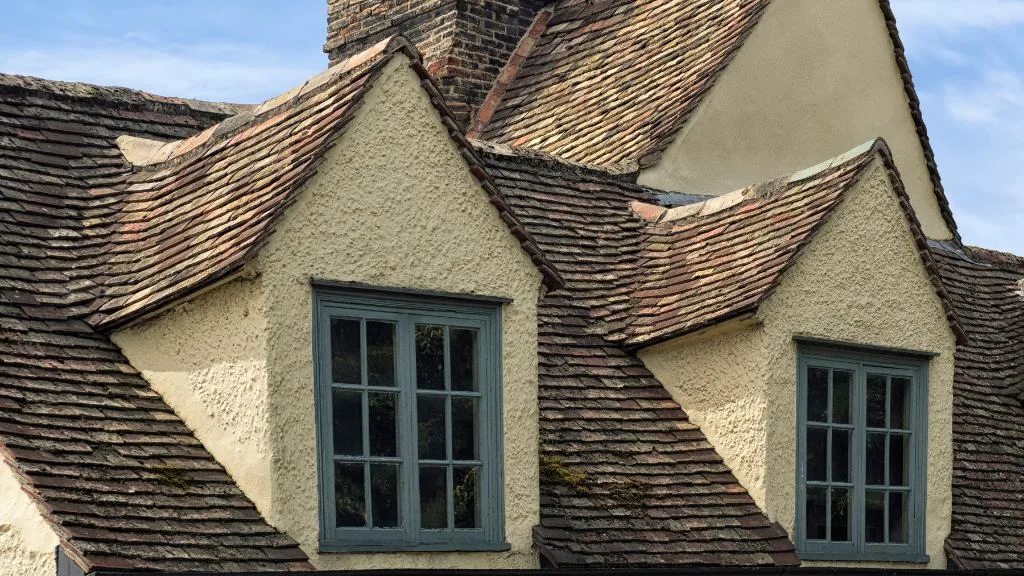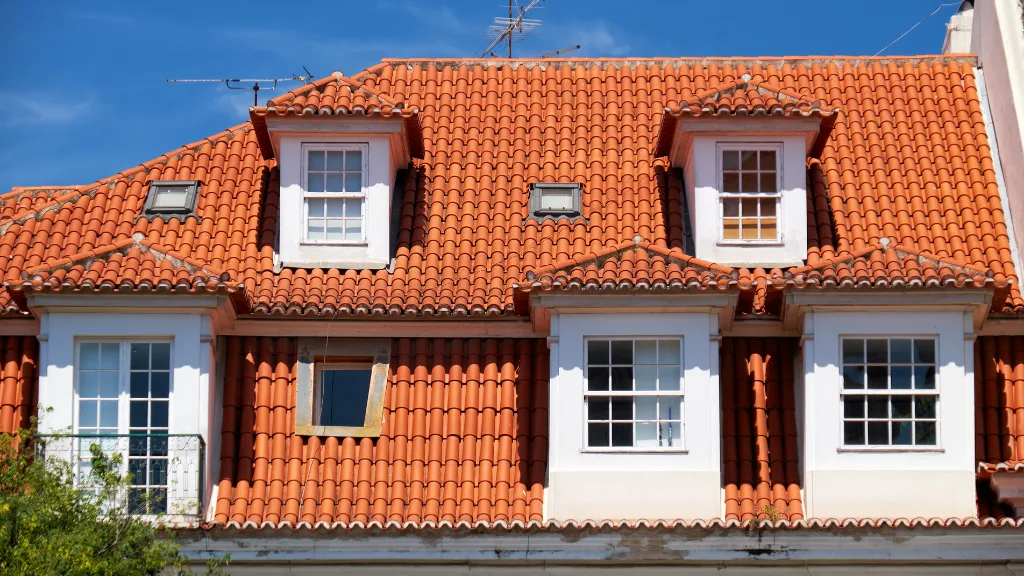
What type of roof do you prefer? The hip or the gable?
This is a question that many people have when they are considering what style to install on their homes. In this blog post we settle the debate; Hip vs Gable Roof? Which is better?
Some believe that a gable roof is better because it provides more headroom in the attic, while others feel that a hip roof will last longer and provide better protection from rain.
In this article, we will review the pros and cons of both types of roofs so you can make an educated decision!
Why a Roof is Important
The roof of your home is one of the most important aspects. It protects you from rain, snow, wind and other elements so that you can live inside comfortably.
A high-quality roof will last for decades before needing to be replaced making it a worthy investment!
There are 2 types of roofs commonly used, namely: gable roofs and hip roofs.
The main difference between a gable roofing and a hip roofing are its slopes. Gable roofs have two slopes on each side of the structure while hip roof has four.
The gable roof is not as steeply sloped when compared to a hip roof, so it does not shed water away from the home very quickly.
This can lead to more moisture damage in homes that are located in wetter climates.
However, because there are two slopes on each side of the home that run parallel to the ground, it does provide more headroom in garages and attics than a hip roof.
Gable Roofs
A gable roof has two sloping surfaces on each side of the structure.
It was initially used to create more space in attics and garages for storage, but it is also a very attractive design element on homes that are not too tall or wide.
Pros of Gable Roofs
Water Shes and Snow – Because there is more of a gradual slope when compared to hip roofs, gable roofs shed water and snow off the side of homes very quickly.
This reduces the amount of damage that can be caused by heavy precipitation!
Attic Space – Gable roofing has two sloping surfaces on each side of the home so it provides more headroom in garages and attics than a hip roof.
This also prevents your attic from being too hot in the summertime because there is no direct sunlight falling on it!
More Affordable – Gable roofs are less expensive to install than hip roofing.
Cons of Gable Roofs
Less Durable – when it comes to wind and snow, gable roofs are not as durable when compared to hip roofing.
The more gradual slope does not shed water and snow off the side of homes quickly enough, which can lead to damage from precipitation!
Simple Design – does mean it has less curb appeal than a hip roof. It is also less complicated to build than a hip roof.

Gable Roof Variations
You’ll find out a couple of gable variations…
Front Gable Roof
This is the most common of gable roofing. It has two sloping surfaces that run parallel to the ground on each side of a structure and it creates more space in attics and garages for storage!
Cross-gable Roof
A cross-gable roof is a type of gable roofing that has two sloping surfaces on the front and rear sides of a structure. It creates more space in attics and garages for storage
Dutch Gable Roof
The Dutch Gable roofs have just one slope on each side of a home, which means it does not provide as much headroom in garages and attics.
Hip Roofs
A hip roof has sloping surfaces on all four sides and looks like an upside-down “V”. It is considered a more durable design than the gable roof because wind does not impact it as strongly.
A hip roof has four sloping surfaces on each side of the structure. It is often used in regions that receive heavy rainfall, because it sheds water away from the home very quickly.
Pros of Hip Roofs
Stability – Hip roofs are well supported by trusses and walls, which makes them more stable during heavy winds.
Snow slides off easily so you don’t have to worry about it crushing you when you go outside in the winter
Protection – Hip roofs provide better protection from rain than gable roofs. This is because water runs straight down each side. Provides better protection from rain, sleet or snow due to lower slopes.
Consistent Eaves – The eaves on a hip roof are consistent from one side to the other. This makes it easier for snow and ice to slide off without accumulating and causing damage
More Attractive – Hip roofs can be built with different pitches, so they’re often more attractive than gable roofs
Used for Lower Slopes – hip roofs are usually used on sloped structures that have lower slopes because they’re more efficient.
The high slope of a hip roof would cause it to shed water too quickly, which could damage the structure
Attic Space – Hip roofs typically provide less attic space than gable roofs do. This is due to their steeper pitch and exterior walls coming inward at each end.
However, they can be constructed to provide more headroom if desired
Roofing Material Used – Hip roofs are typically built using trusses instead of rafters because they’re sturdier and work better with the sloping design
Cons of Hip Roofs
More Expensive – Hip roofs are more expensive to build than gable roofs because they require trusses and there is less headroom
Difficult Access – The hip roof provides access from the top, but it’s difficult to get into without a ladder or scaffolding.
This can be dangerous for anyone who doesn’t know what they’re doing around a building site
Susceptible to Leaks – Hip roofs are more likely to leak than gable roofs. This is because they aren’t as watertight when the trusses and rafters meet in between each side
Snow Issues – Hip roofs can be difficult to clear when it snows, since snow tends to slide off of their longer slopes.

Variations of Hip Roof
Hip roof comes in different variations:
Half-hip Roof
Half-hip roofs are constructed with sloping surfaces that come together at the middle of each side. This creates a ridge on both sides, which looks similar to gable roofs.
Pavilion Roof
Pavilion roofs have sloping surfaces on all four sides that intersect at a single point. This creates two ridges, one in the front and back of the structure.
Mansard Roof
A mansard roof has a flat area on the top and sloping surfaces on all four sides.
They are often used to add more living space in homes, because they provide extra headroom when built with two different pitches.
More Differences Between Hip and Gable Roofs
Shingles Used on a Gable Roof
Shingles are the most widely used roofing material in America. They’re easy to install and require minimal maintenance, but they don’t last as long as some other materials do.
Shingles can be made from asphalt or fiberglass, which is why they come in so many colors and styles.
Material Used on Hip Roofs
Since hip roofs are typically steeper than gable roofs, they’re usually covered with tiles or shingles. They can also be built using trusses instead of rafters to provide more headroom.
Trusses on a Hip Roof
Trusses are typically used as the support system for hip roofs because they provide more stability than rafters.
Trusses can also be covered with tiles or shingles, which is why many homes have exposed truss work in their lower level ceilings. This makes them stand out when you walk into the area.
Gable Roofs vs Hip Roofs
When it comes to roof designs, there are pros and cons with each one.
The gable design is popular for its simplicity but hip roofs provide better protection from weather conditions like rain or snow due to their sloping surfaces.
Hip roofs are typically steeper and have less headroom, so they’re not as long-lasting or durable.
However, they can be built to provide more space if desired. Gable roofs tend to leak because the trusses don’t meet at a peak in between each side of the roofing material
Trusses on a Gable Roof
Gable roofs are the most common style of roofing in America because they’re simple and easy to build. Trusses are typically used for this design, but it’s also possible to use rafters instead.
Hip Roofs vs Gable Roofs
When comparing hip roofs with gable roofs, there are pros and cons of each one.
Hip roofs are more expensive to build because they require trusses and there is less headroom, but gable roofs are typically simpler in design.
Gable roof can be difficult to access without a ladder or scaffolding when snow accumulates on the roof, while hip roofs provide easier entry points throughout their surface area.
Having a Quality Roofing System and Materials is Essential
When it comes to your roof, you should work with a reputable contractor who can provide the best materials and insurance throughout the process.
This will ensure that all of your needs are met when installing or replacing an existing roofing system on your property.
Benefits of Having Quality Roofing Systems
Having quality roofing systems can help to prolong the life of your home, which means you won’t have to incur costly repairs or replacements.
It’s important that roofs are properly insulated and installed with materials that will work in all types of weather conditions.
Snow Issues – Hip roofs can be difficult to clear when it snows, since snow tends to accumulate on the steeper parts of the roof.
Gable roofs typically have less snow buildup and can be easily cleared with a shovel or brush, which means you won’t need to hire someone for maintenance service throughout the winter months.
The Best Roofing Material – Each type of roof has its own pros and cons when it comes to construction materials.
Hip roofs can be made from a variety of materials, including metal or tile. However, gable roofs typically use shingles or tiles due to their durability and weather-resistant properties.
What is the Best Roof Design?
When it comes down to hip vs gable roof design, there are pros and cons of each one.
Gable roofs are the simpler of the two designs and typically don’t require trusses for support, while hip roofs can be built to provide more height or space if needed.
Hip roofs tend to last longer but they’re not as easy to access without a ladder when snow accumulates on top.
Gable roofs have less headroom due to their sloping construction and therefore aren’t as durable or long-lasting.
When it comes to choosing a roofing material, there are pros and cons of each type – metal is more expensive but provides better insulation throughout the year, while shingles can be damaged if they’re exposed to too much heat from the sun during summer months.
Both types of roofs can be built and designed to provide more height or space, but gable roofs typically have less headroom than hip roofs.
Expectations When Investing in Quality Roofs
When choosing the best roofing material, it’s important to explore all of your options and consider what you want out of a new or existing roof.
Hip roofs are typically steeper than gable roofs but can provide more headroom if needed.
Gable roofs have trusses that prevent leaks during heavy rainfall but they also need to be accessed during snowy months.
When it comes to the best roofing material, there are pros and cons of each type – metal is more expensive but provides better insulation throughout the year, while shingles can be damaged if they’re exposed to too much heat from the sun during summer months.
Both types of roofs can be built and designed to provide more height or space, but gable roofs typically have less headroom than hip roofs.
It’s important to consider what you want out of a roof when investing in quality materials and systems – each type has its own pros and cons that may be more suitable for your needs throughout the year.
Gable roofs are simpler in design but they tend to lose insulation during winter months.
Hip roofs are more complicated to build but they provide better insulation throughout the year while also providing more headroom in some cases.
Hiring an Expert Roofing Contractor
One of the biggest benefits to hiring an expert roofing contractor is that they can provide recommendations for different types of roofs based on your location.
Hip vs gable roofs are popular in some parts of the country but less common elsewhere, which means you’ll need someone who knows what type will work best where you live.
When it comes down to the best roofing material, there are pros and cons of each type – metal is more expensive but provides better insulation throughout the year, while shingles can be damaged if they’re exposed to too much heat from the sun during summer months.
Both types of roofs can be built and designed to provide more height or space, but gable roofs typically have less headroom than hip roofs.
You’ll never want to waste your investment on the roofing materials that don’t work for you, which means finding an expert roofing contractor who can help you ensure the right materials are chosen.
Hip roofs tend to last longer but they require more complicated construction and therefore aren’t as accessible during snowy months without a ladder.
Gable roofs have trusses that protect them from leaks during heavy rainfall but these types of roofs can be damaged by too much heat from the sun.
Both types of roofs provide more headroom than gable roofs and therefore boast better insulation during winter months but hip roofs require a lot of extra work to build and maintain throughout the year.
Hiring an expert roofing contractor is one of the best ways to ensure you’re choosing quality materials that work for your roof.
Without investing in the right materials, you’ll pay more over time because repairs and replacements will need to be done more often than if they were chosen correctly from the start.
